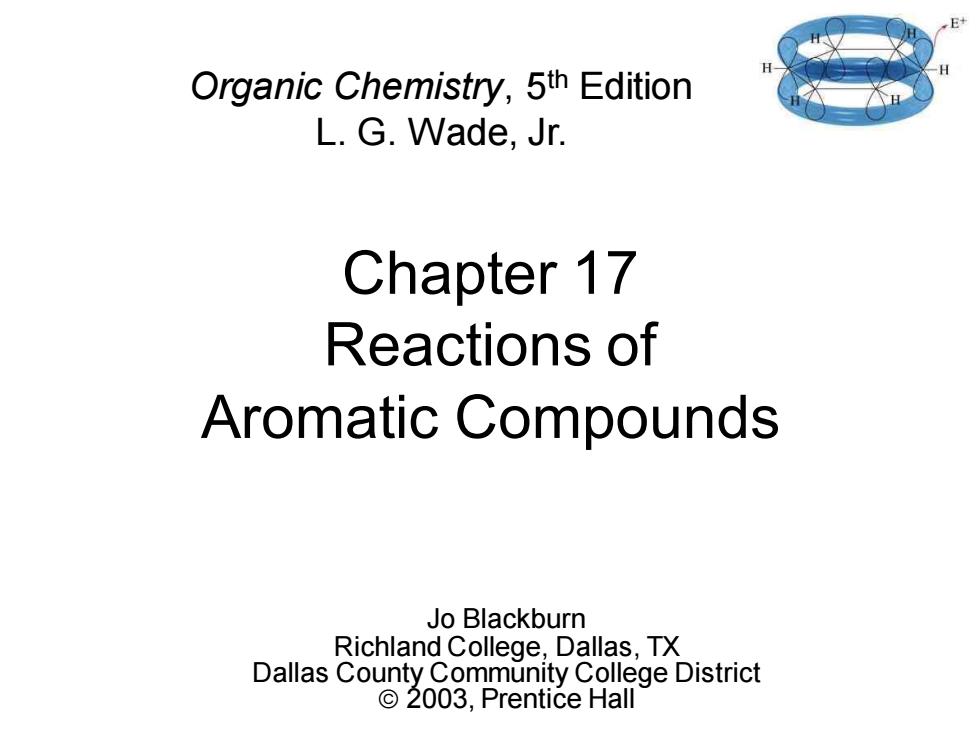
E Organic Chemistry,5th Edition L.G.Wade,Jr. Chapter 17 Reactions of Aromatic Compounds Jo Blackburn Richland College,Dallas,TX Dallas County Community College District ©2003,Prentice Hall
Chapter 17 Reactions of Aromatic Compounds Jo Blackburn Richland College, Dallas, TX Dallas County Community College District © 2003, Prentice Hall Organic Chemistry, 5th Edition L. G. Wade, Jr

Electrophilic Aromatic Substitution Electrophile substitutes for a hydrogen on the benzene ring. sigma complex substituted => Chapter 17 2
Chapter 17 2 Electrophilic Aromatic Substitution Electrophile substitutes for a hydrogen on the benzene ring. =>

E+ Mechanism Step I:Attack on the electrophile forms the sigma complex. E sigma complex(arenium ion) Step 2:Loss of a proton gives the substitution product. H H base E base-H H H Chapter 17 3
Chapter 17 3 Mechanism =>

H Bromination of Benzene Requires a stronger electrophile than Br2. Use a strong Lewis acid catalyst,FeBr3. :Br-Br:FeBr3→ Br-Br—FeBr3 H Animation H H H H H Br Br-Br-FeBr3 +FeBr4 H Animation H Animation + HBr => Chapter 17
Chapter 17 4 Bromination of Benzene • Requires a stronger electrophile than Br2 . • Use a strong Lewis acid catalyst, FeBr3 . Br Br FeBr 3 Br Br FeBr 3 Animation Br Br FeBr3 H H H H H H H H H H H H Br + + FeBr4 _ Animation Br Animation + HBr =>

Energy Diagram for Bromination rate-limiting transition state reactants H +Br2 Br -FeBr4 +FeBr3 intermediate products Br +HBr 10.8 kcal/mol +FeBr3 reaction coordinate => Chapter 17 5
Chapter 17 5 Energy Diagram for Bromination =>

Chlorination and lodination Chlorination is similar to bromination. Use AIClg as the Lewis acid catalyst. lodination requires an acidic oxidizing agent,like nitric acid,which oxidizes the iodine to an iodonium ion. H HNO3 +1/2 I2>I+NO2 H2O => Chapter 17 6
Chapter 17 6 Chlorination and Iodination • Chlorination is similar to bromination. Use AlCl3 as the Lewis acid catalyst. • Iodination requires an acidic oxidizing agent, like nitric acid, which oxidizes the iodine to an iodonium ion. H + HNO3 I 2 1/2 I + + + + NO2 + H2 O =>

Nitration of Benzene Use sulfuric acid with nitric acid to form the nitronium ion electrophile. H H HSO4 0 H-O-N 60* N NO2*then forms a sigma complex with benzene,loses H+to form nitrobenzene.= Chapter 17 7
Chapter 17 7 Nitration of Benzene Use sulfuric acid with nitric acid to form the nitronium ion electrophile. H O N O O H O S O H O O + HSO4 _ H O N H O O + H O N H O O + H2O + N O O + NO2 + then forms a sigma complex with benzene, loses H+ to form nitrobenzene. =>

Sulfonation Sulfur trioxide,SO3,in fuming sulfuric acid is the electrophile. ,一于 :一 benzenesulfonic acid Chapter 17 8
Chapter 17 8 Sulfonation Sulfur trioxide, SO3 , in fuming sulfuric acid is the electrophile. S O O O S O O O S O O O S O O O + + + _ _ _ S O O O H S O O O H + _ S HO O O benzenesulfonic acid =>

Desulfonation All steps are reversible,so sulfonic acid group can be removed by heating in dilute sulfuric acid. This process is used to place deuterium in place of hydrogen on benzene ring. H large excess D2S04/D20. => H D Chapter 17 Benzene-d6 9
Chapter 17 9 Desulfonation • All steps are reversible, so sulfonic acid group can be removed by heating in dilute sulfuric acid. • This process is used to place deuterium in place of hydrogen on benzene ring. Benzene-d6 => D D D D D D D2SO4/D2O large excess H H H H H H

Nitration of Toluene Toluene reacts 25 times faster than benzene. The methyl group is an activator. The product mix contains mostly ortho and para substituted molecules. CH3 CH HNO3. H2SO NO NO2 toluene o-nitrotoluene m-nitrotoluene p-nitrotoluene (60%) (4%) (36%)】 三> Chapter 17 10
Chapter 17 10 Nitration of Toluene • Toluene reacts 25 times faster than benzene. The methyl group is an activator. • The product mix contains mostly ortho and para substituted molecules. =>